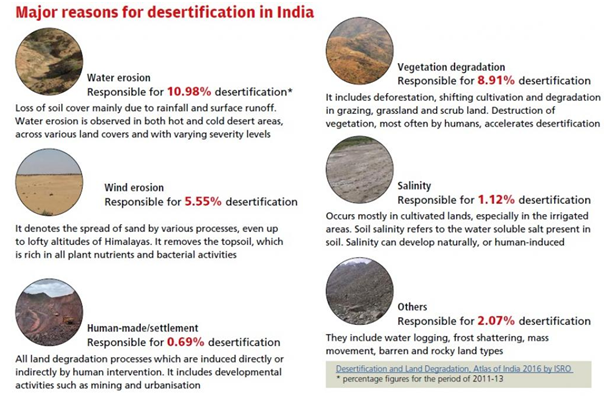

A major discussion on ways to reverse land degradation and its outcomes is being held at the 14th session of the Conference of the Parties (COP14) to UNCCD in Greater Noida, New Delhi, from September 2 to 13.
Context
A major discussion on ways to reverse land degradation and its outcomes is being held at the 14th session of the Conference of the Parties (COP14) to UNCCD in Greater Noida, New Delhi, from September 2 to 13.
About
- India will host the 14th Conference of Parties (COP14) of the United Nations Convention to Combat Desertification (UNCCD).
- The event expects more than 3,000 participants from across the world to gather at India Mart and Expo, Greater Noida, from September 2-13.
- The participants will include ministers from 196 countries, representatives of national and local governments, city leaders, community groups, scientists, non-governmental organisations, the private sector and industry experts.
- Main agendas for COP14 are reversing land degradation and its outcomes while accelerating positive achievements for people and for ecosystems with a view to deliver on the United Nations- mandated Sustainable Development Goals.
- Land degradation working in tandem with climate change and biodiversity loss may force up to 700 million people to migrate by 2050.
Land degradation/ Desertification
- UNCCD defines desertification as “land degradation in arid, semi-arid and dry sub-humid areas resulting from various factors, including climatic variations and human activities”.
- Drylands affected by desertification not only lose their ability to support plant life, but also their ability to offer ecosystem services, such as management of water systems and storage of carbon use in global warming.
- Desertification has occurred throughout history. But what’s alarming is that its pace has accelerated 30 to 35 times the historical rate in the recent decades.
- With changing climate, prolonged droughts and increasing incidences of floods, landslides and frost heaving are in any case reducing the amount of productive land.
- At the same time, growing demand for food, fodder, fuel and raw materials is increasing the pressure on land and the competition for natural resources.
- Factors like deforestation, wetland drainage, overgrazing, unsustainable land use practices and the expansion of agricultural, industrial and urban areas are the other significant causes of land degradation
Desertification in India
- According to Desertification and Land Degradation of Selected Districts of India, an atlas published by the Indian Space Research Organisation’s Space Application Centre (SAC), Ahmedabad in 2018, some 96.40 million ha, or about 30 per cent of the country’s total area, is undergoing degradation. This means almost a quarter of India is under desertification.
- Of India's total geographical area of 328.72 million hectares (MHA), 4 MHA is under desertification.
- In eight states—Rajasthan, Delhi, Goa, Maharashtra, Jharkhand, Nagaland, Tripura and Himachal Pradesh—around 40 to 70 per cent of land has undergone desertification.
- More to it, 26 of 29 Indian states have reported an increase in the area undergoing desertification in the past 10 years.
- Major Reasons
- Loss of soil cover, mainly due to rainfall and surface runoff, is one of the biggest reasons for desertification. It is responsible for 98 per cent of desertification in the country.
- Water erosion is observed in both hot and cold desert areas, across various land covers and with varying levels of severity.
- The next big reason is wind erosion

United Nations Convention to Combat Desertification (UNCCD)
- Established in 1994, the United Nations Convention to Combat Desertification (UNCCD) is the sole legally binding international agreement linking environment and development to sustainable land management.
- The Convention addresses specifically the arid, semi-arid and dry sub-humid areas, known as the drylands, where some of the most vulnerable ecosystems and peoples can be found.
- The new UNCCD 2018-2030 Strategic Framework is the most comprehensive global commitment to achieve Land Degradation Neutrality (LDN) in order to restore the productivity of vast expanses of degraded land and reduce the impacts of drought on vulnerable populations.
- As the dynamics of land, climate and biodiversity are intimately connected, the UNCCD collaborates closely with the other two Rio Conventions; the Convention on Biological Diversity (CBD) and the United Nations Framework Convention on Climate Change (UNFCCC), to meet these complex challenges with an integrated approach and the best possible use of natural resources.



